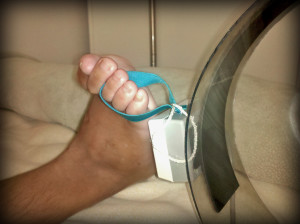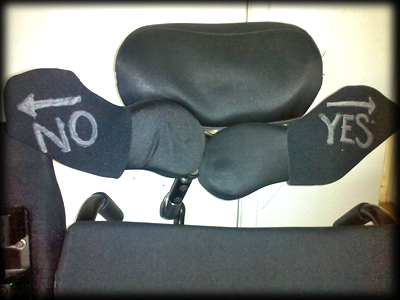
A lot has been happening (or not happening) in Patty’s world depending upon one’s point of view. This photo was taken today by Teresa B. and it shows a “tweak” Teresa fashioned to help stabalize the switch Patty uses with her feet. As mentioned elsewhere on this blog, a switch strategy is part of Patty’s overall communication rehabilitation. I don’t think I’ve ever used that term—communication rehabilitation—but it seems to fit. When Patty activates the switch with her foot it communicates sooooooo much.
First, the switch is evidence of Patty’s receptive language—her ability to hear, understand and respond to her environment. By accessing and activating the single-switch in a conversation, Patty is pretty much telling us that she’s in the room and certainly part of the conversation. Teresa B. has been Patty’s friend, advocate and guide throughout this long communication journey. The photo is just another tweak up Teresa B.’s long sleeve. Talk about creative arts.
So that’s the latest good news. The rest pivots upon who understands and believes in Patty’s recovery. Initially, recognizing the magnitude of Patty’s efforts may not be immediately apparent. It takes time, is often subtle, and sometimes may even require a bit of faith. It’s certainly not obvious in a brief medical examination or consultation when time is driving everything—including quality of life issues. And yet, the time it may take hardly diminishes the reality and significance of Patty’s efforts and achievements.
Recently, the videos on this blog, recording Patty’s effort and progress, were characterized as a “trick” and not to be believed. The injustice and unfairness of such a statement is tragic and I’m still trying to figure out how to digest that one. Patty certainly deserves more, far more.
—MS











